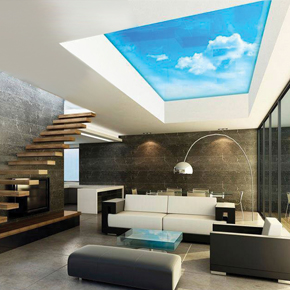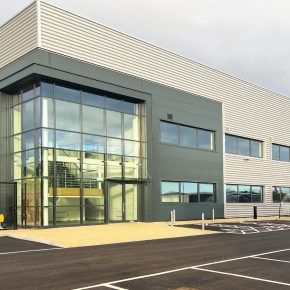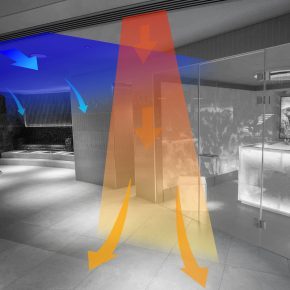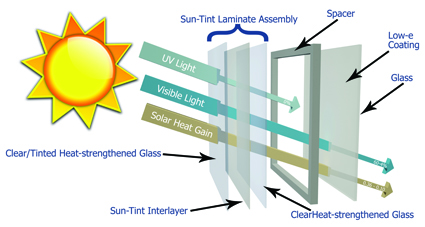
Dynamic glazing: the future of roof windows
In a market driven by the need for greater energy efficiency, impressive modern aesthetics and superior lifestyle benefits, Andrew Huddlestone, CEO of Roof Maker, explains how roof windows and skylights are now ready for the next major step forward…
In recent years we have seen significant advances in the design of skylights and roof windows with the introduction of multilayer glazing (triple and quadruple), lighter and slimmer systems, lower U-values and more sophisticated coatings.
Manufacturers of rooflights are also incorporating more and more advanced solar control glazing options in order to provide sustainable energy saving solutions that will help reduce CO2 emissions.
The next step lies with the introduction of dynamic and intelligent technologies, which are better able to meet the needs of today’s society. Far from being blue sky concepts, a number of chromogenic technologies, which can change the tint or colour of the glazing and alter heat and light transmission have already been developed. These broadly fall into two types: active user-controlled glass or passive glazing, which responds to changes in the environment.
Roof windows and skylights with electrically switching or electrochromic glazing, which changes its state from transparent to opaque in response to a low voltage electric current, are already commercially available in America but have not made significant inroads into the UK market.
Operated through the flick of a switch or through a mobile device, they offer complete user control. Their dependence on an expensive network of wiring and controls and their inability to respond intuitively to their environment can be considered a disadvantage, however.
A new generation of dynamic roof windows and skylights with passive thermochromic glazing is now available. Known as Sun-Tint in the UK, it offers a much more intuitive solution, by which the glazing automatically self-tints in response to changes in the external temperature and climate. Without the need for electrical components it is also more economical to manufacture and install.
Though the technology is complex, the concept is straight-forward. Thermochromic glazed units are constructed with a polyvinyl butyral (PVB) interlayer placed between two pieces of heat strengthened or tempered glass, which responds to the direct heat of the sun, causing the glass to lighten and darken by itself throughout the day. The more intense the sunlight the darker the glass becomes, reducing any glare and dazzle. Then, in cloudy or overcast conditions, when there is no direct sunlight, the glass cools and gradually returns to its clear and transparent state, allowing in as much daylight as possible.
As the change in light transmission is gradual and subtle, ranging from 50% (cloudy day) down to 10% (direct overhead sunlight), it does not compromise the clarity or overall visibility, but automatically adjusts the levels of daylight, creating a healthier, more consistent and comfortable living or working environment.
The performance and cost benefits are considerable. In addition to offering improved natural daylighting, dynamic rooflights with this type of thermochromic glazing have a much more precise solar heat gain coefficient control than skylights using traditional solar glass, regardless of their position or the angle of the roof. Furthermore, their ability to continuously adapt to external climatic conditions helps to maintain a natural balance, reducing energy consumption from heating, lighting and air conditioning in buildings.
During bright sunlight, the PVB interlayer reduces solar gain, blocking the amount of IR rays and UV light allowed through the glass, so that the room does not overheat in the summer months. Then, in cooler winter conditions, when the glass is clear, it will allow 100% passive solar heat through, so that the warmth from the sun’s rays can be captured within the room.
The solar heat gain ranges from 0.36 – 0.16. By combining this dynamic technology with high performance low-E insulating glass, significantly lower U- values (0.6w/m2k) can also be achieved.
In this highly competitive market, where architects, specifiers and end users are looking for better performance, greater energy efficiency and more value for money, dynamic rooflights with the ability to manage passive solar heat gain and natural daylight in order to reduce energy costs and improve the indoor environment could be setting a new standard for the future.
Roof-Maker
1 Pinfold Road
Thurmaston
Leicester
LE4 8AS
Visit Supplier's page
Latest news

2nd April 2025
FIT Show 2025 Launches Innovative Marketplace Feature to Enhancing Value for Installers
FIT Show, the UK’s leading event for the window, door, flat glass, hardware, and roofing industries, is excited to announce the launch of a brand new Marketplace feature at its upcoming 2025 event (Birmingham NEC, 29 April – 1 May).
Posted in Architectural Ironmongery, Articles, Building Industry Events, Building Industry News, Building Products & Structures, Doors, Exhibitions and Conferences, Glass, Glazing, Hand Tools, Innovations & New Products, Plant, Equipment and Hire, Power Tools, Restoration & Refurbishment, Retrofit & Renovation, Roofs, Seminars, Training, Windows
2nd April 2025
Hi-spec deployment of EJOT Colorfast at new Birmingham logistics park
EJOT Colorfast fasteners have been used extensively in the construction of eight new high-specification warehousing and logistics buildings at the Urban 8 Logistics Park in King’s Norton, Birmingham.
Posted in Articles, Building Industry News, Building Products & Structures, Building Systems, Case Studies, Facades, Restoration & Refurbishment, Retrofit & Renovation, Roofs, Walls
2nd April 2025
SWA member delivers ‘fresh Hope’ for university’s Sustainable Building department
A detailed contract to restore an iconic Art Deco building in the heart of Birmingham’s Jewellery Quarter was carried out by Steel Window Association member, The Window Repair Company (Northwest) Limited.
Posted in Articles, Building Associations & Institutes, Building Industry News, Building Products & Structures, Building Systems, Case Studies, Glass, Glazing, Restoration & Refurbishment, Retrofit & Renovation, Steel and Structural Frames, Sustainability & Energy Efficiency, Windows
1st April 2025
Gilberts Takes Thermal Comfort to New Heights
Gilberts Blackpool is continuing to build on its reputation as a pioneer with the unveiling of ThermaAstute™ – the most extensive range of thermally sensitive diffusers in the market.
Posted in Air Conditioning, Articles, Building Industry News, Building Products & Structures, Building Services, Facility Management & Building Services, Heating, Ventilation and Air Conditioning - HVAC, Innovations & New Products, Restoration & Refurbishment, Retrofit & Renovation, Sustainability & Energy Efficiency
 Sign up:
Sign up: 